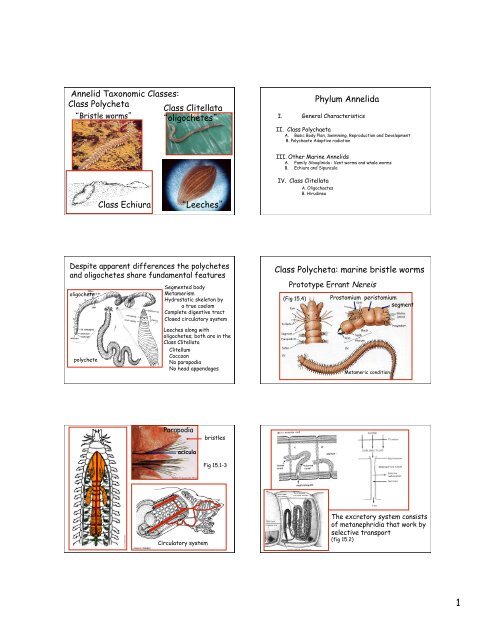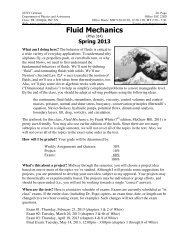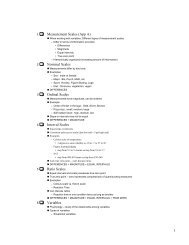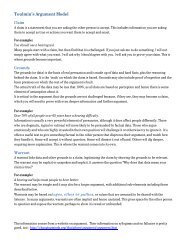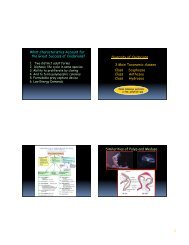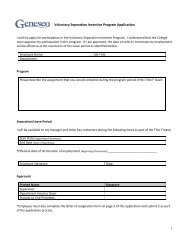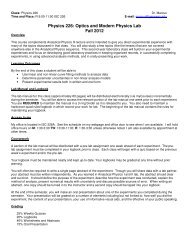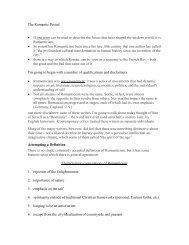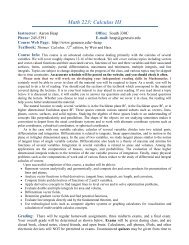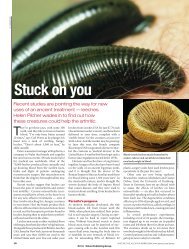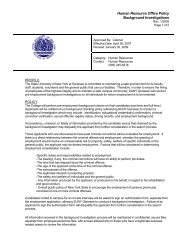Intro to Annelids
Intro to Annelids
Intro to Annelids
You also want an ePaper? Increase the reach of your titles
YUMPU automatically turns print PDFs into web optimized ePapers that Google loves.
Annelid Taxonomic Classes:<br />
Class Polycheta<br />
Class Clitellata<br />
“Bristle worms” “oligochetes”<br />
Phylum Annelida<br />
I. General Characteristics<br />
II. Class Polychaeta<br />
A. Basic Body Plan, Swimming, Reproduction and Development<br />
B. Polychaete Adaptive radiation<br />
Class Echiura<br />
“Leeches”<br />
III. Other Marine <strong>Annelids</strong><br />
A. Family Siboglinida : Vent worms and whale worms<br />
B. Echiura and Sipuncula<br />
IV. Class Clitellata<br />
A. Oligochaetes<br />
B. Hirudinea<br />
Despite apparent differences the polychetes<br />
and oligochetes share fundamental features<br />
oligochete<br />
Segmented body<br />
Metamerism<br />
Hydrostatic skele<strong>to</strong>n by<br />
a true coelom<br />
Complete digestive tract<br />
Closed circula<strong>to</strong>ry system<br />
Class Polycheta: marine bristle worms<br />
Pro<strong>to</strong>type Errant Nereis<br />
(Fig 15.4)<br />
Pros<strong>to</strong>mium peris<strong>to</strong>mium<br />
segment<br />
polychete<br />
Leeches along with<br />
oligochetes; both are in the<br />
Class Clitellata<br />
Clitellum<br />
Coccoon<br />
No parapodia<br />
No head appendages<br />
Metameric condition<br />
Parapodia<br />
bristles<br />
acicula<br />
Fig 15.1-3<br />
Circula<strong>to</strong>ry system<br />
The excre<strong>to</strong>ry system consists<br />
of metanephridia that work by<br />
selective transport<br />
(fig 15.2)<br />
1
Polychete Reproduction:<br />
Gametes form from cells that line the coelom<br />
Some copulate but most form Epi<strong>to</strong>kes<br />
• Hierarchical System of Controls<br />
- Day length cues seasonal<br />
reproduction<br />
– Lunar Cycles synchronize local<br />
spawning events<br />
(Fig 17)<br />
- Meteorological phenomena are<br />
likely the final trigger <strong>to</strong> epi<strong>to</strong>ky<br />
In Fiji and Samoa, palolo worms swarm<br />
on the 7th night after the full moon<br />
that follows the autumnal equinox!!<br />
Odon<strong>to</strong>syllis enopla<br />
- Complex Sex Pheromones<br />
synchronize nuptual dance and<br />
spawning<br />
Corresponding structures in a trochophore larva<br />
and in an adult polychete.<br />
Polychete Reproduction<br />
(similarities <strong>to</strong> mollusca)<br />
Fig 18<br />
Adaptive Radiation in Polychaetes<br />
-- metameric body plan of Nereis and other errants is<br />
the basic condition<br />
-- some are adapted <strong>to</strong> live in the plank<strong>to</strong>n: swimming<br />
polychaetes like Tomopteris<br />
-- burrowing polycheates are “earthworm-like”<br />
-- sedentary forms secrete tubes or dwell in burrows;<br />
head has prominent tentacles for suspension or deposit<br />
feeding.<br />
-- some are highly specialized tube dwellers<br />
Crawlers<br />
• Head prominent<br />
• Crawling parapods<br />
• Eversible pharynx<br />
some spp. with<br />
poison glands.<br />
Burrowers<br />
• Move by peristalsis<br />
• Head streamlined<br />
• Parapods reduced<br />
• Deposit Feeders<br />
“earthworm-like”<br />
Swimmers<br />
• Large parapods<br />
• Transparent body<br />
• Enormous eyes<br />
• Active preda<strong>to</strong>rs<br />
Tube dwellers<br />
• Movement limited<br />
• Head reduced but<br />
with tentacles<br />
• Parapods small<br />
• Passive and Active<br />
suspension feeders<br />
• Filter Feeders<br />
2
Annelid Taxonomic Classes:<br />
Polychaete<br />
Family<br />
Siboglinidae<br />
F. Siboglinidae :<br />
Perviates<br />
< 1mm diameter<br />
10 - 74 cm long<br />
(spaghetti worms)<br />
opisthosoma<br />
Class Echiura<br />
“<br />
Fig 13.12-13.14<br />
6-25 segments containing coelomic<br />
compartments that are isolated<br />
from each other by muscular septa;<br />
each segment bears chitinous setae<br />
Newest<br />
Siboglinidae<br />
F. Siboglinidae<br />
Vestimentiferans<br />
(vent worms)<br />
plume<br />
heart<br />
V blood vessel<br />
trophosome<br />
Osedax<br />
tube<br />
Rouse, GW. et al. 2004<br />
Fig 13.15-16<br />
“... small but very intriguing group…”<br />
Archea and other<br />
bacteria abound!<br />
• Live in the deepest parts of the ocean<br />
• No digestive system<br />
• Thrive in areas of high methane or sulfur<br />
• Trophosome with bacteria<br />
3
No light yet a very rich community<br />
of exotic marine organisms?<br />
Experiment: Use of sulfur by trophosome bacteria<br />
SO 3<br />
-<br />
SH -<br />
S 2 O 3<br />
--<br />
No light yet a very rich community<br />
of exotic marine organisms?<br />
Bacterial Chemosynthesis<br />
CO 2 + H 2 S + O 2 [CH 2 O] n + H 2 SO 4<br />
Pho<strong>to</strong>synthesis<br />
Fig 17.5<br />
But H 2 S usually inhibits<br />
Cy<strong>to</strong>chrome c oxidase activity (ETS enzyme)<br />
Does vent worm Cyt c <strong>to</strong>lerate H 2 S?<br />
Is sulfide somehow de<strong>to</strong>xified?<br />
Expts. By M. Powell and George Somero<br />
“The Echiura”<br />
With Addition of<br />
pogonophoran blood<br />
Hemoglobin<br />
Binds <strong>to</strong> sulfide<br />
Molecules<br />
With scoop-shaped proboscis<br />
Main body is large coelom<br />
Fig 13.26-13.29<br />
Muco-ciliary deposit feeders<br />
Live in sand, mud, crevices<br />
“Fat inkeeper” worm is best known representative<br />
“The Sipuncula”<br />
Ecologically and functionally like Echiura<br />
Instead of a proboscis a fully retractable<br />
head region known (introvert) aids feeding<br />
4
The Sipuncula:<br />
Some Annelid (Echiura) vs Sipuncula Characteristics<br />
Annelid-like<br />
Characteristic Echiura Sipuncula<br />
Musculature outer circular and inner longitudinal<br />
Setae Present Absent<br />
Metamerism early juvenile Absent<br />
- Fewer than 600 species; found primarily in shallow<br />
marine habitats; deposit/detritus feeders<br />
- Soft bodied, with very poor fossil record, but with<br />
distinctly pro<strong>to</strong>s<strong>to</strong>mous embryological characters<br />
- Not as abundant or as ecologically important as annelids<br />
Coelom form.<br />
Cleavage<br />
Larval form<br />
All have schizocoelous formation<br />
All with spiral determinate cleavage<br />
The trochophore is the first larva<br />
5


